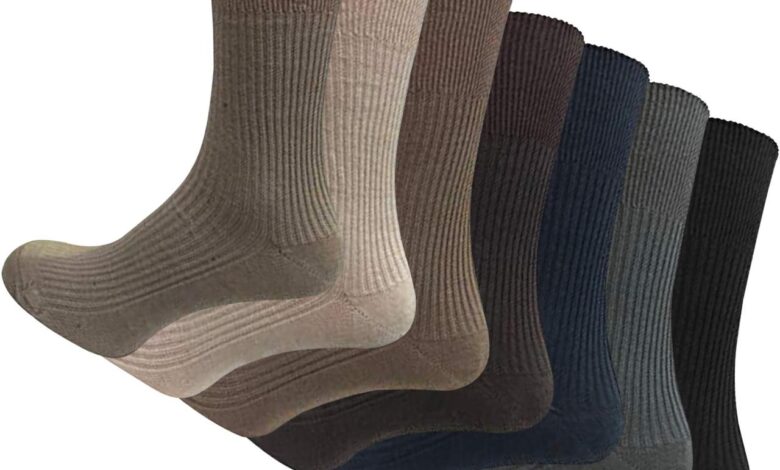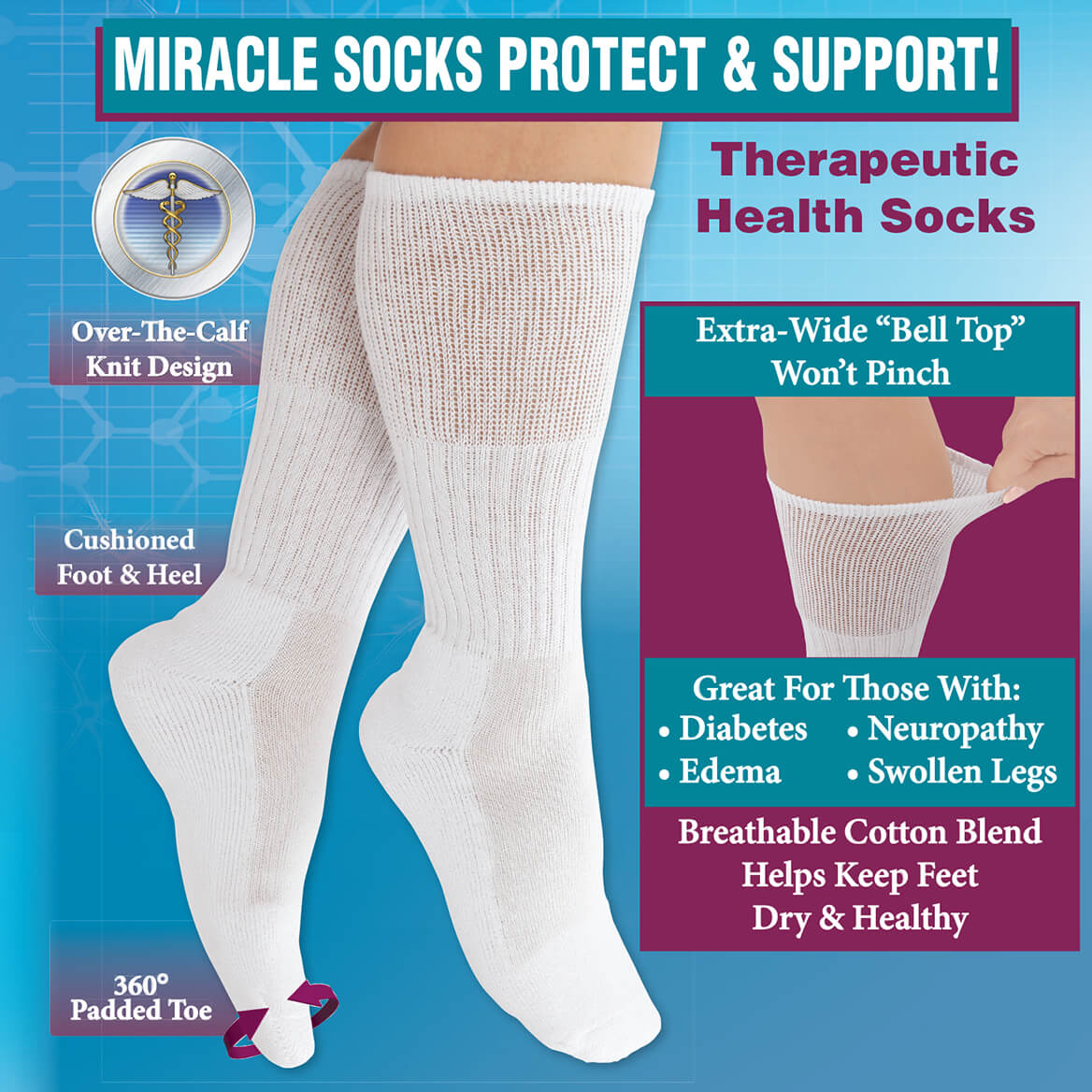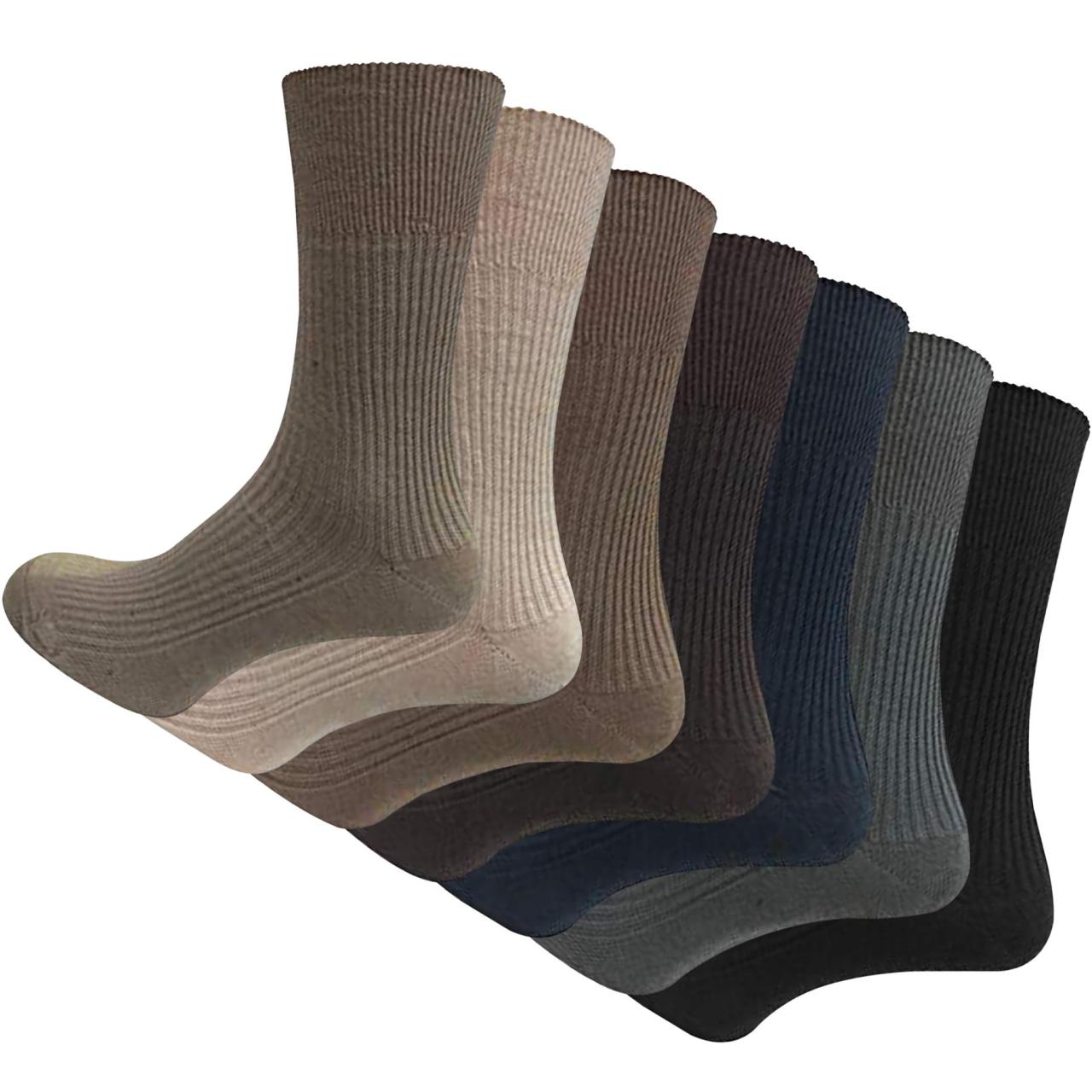
Top brands of diabetic socks what can they do for you? This guide delves into the world of specialized footwear for those with diabetes, exploring the crucial role these socks play in foot health. We’ll examine top brands, highlighting their features and benefits, and discuss how the right socks can prevent serious complications. Learn about different types of diabetic socks, crucial features to look for, and essential care tips.
Diabetic socks are specifically designed to address the unique needs of individuals with diabetes, offering comfort, support, and protection for sensitive feet. They often feature enhanced cushioning, compression, and moisture-wicking properties to promote healthy blood circulation and prevent issues like blisters and ulcers. Choosing the right brand and type of sock is critical for managing potential foot complications effectively.
Introduction to Diabetic Socks
Diabetic socks are specialized footwear designed to protect the feet of individuals with diabetes. Proper foot care is crucial for people with diabetes due to the increased risk of nerve damage (neuropathy), poor circulation, and reduced sensation. Diabetic socks play a vital role in mitigating these risks, preventing complications, and promoting overall foot health.These socks are not just another pair of socks; they offer a unique combination of features and benefits that conventional socks lack.
They are engineered to address the specific needs of diabetic individuals, providing enhanced support, cushioning, and protection against potential foot problems. This focus on proactive foot care is essential for maintaining comfort and preventing more serious complications.
Types of Diabetic Socks
Diabetic socks come in various styles, each catering to different needs and preferences. Understanding the available types helps individuals choose the most suitable socks for their specific foot conditions and lifestyle.
- Cushioned Diabetic Socks: These socks feature extra padding in the high-wear areas of the foot, providing significant cushioning to protect sensitive skin and bony prominences from friction and pressure. This cushioning helps prevent blisters, sores, and other foot problems that can lead to infections. A common example of this is socks with extra padding on the heels and toes.
- Compression Diabetic Socks: These socks are designed to provide graduated compression, which helps improve blood circulation and reduce swelling in the legs and feet. Compression socks are particularly beneficial for individuals with poor circulation, as they can help prevent blood pooling and promote healthy blood flow to the feet. The graduated compression, meaning the pressure is stronger at the ankles and lessens towards the upper leg, helps in improving venous return.
- Moisture-Wicking Diabetic Socks: These socks are designed to absorb moisture and prevent the buildup of sweat and bacteria on the skin. This helps maintain a dry environment, which is critical in preventing fungal infections and skin breakdown, common concerns for people with diabetes. These socks often feature moisture-wicking fabrics like merino wool or specialized synthetic materials.
- Anti-Slip Diabetic Socks: Designed with special grips or textures on the sole to help prevent slips and falls. These are particularly helpful for individuals with reduced sensation or balance issues. This added grip can prevent falls, which is especially important for those with diabetes who may have difficulty feeling their feet.
Comparison of Diabetic Sock Types
The following table provides a comparative overview of different diabetic sock types, highlighting their key features and benefits:
| Sock Type | Cushioning | Compression | Moisture-Wicking | Anti-Slip |
|---|---|---|---|---|
| Cushioned | High | Low | Variable | Low |
| Compression | Moderate | High | Variable | Low |
| Moisture-Wicking | Low | Low | High | Low |
| Anti-Slip | Moderate | Low | Variable | High |
Top Brands of Diabetic Socks

Finding the right diabetic socks can be a game-changer for comfort and well-being. These specialized socks are designed to prevent and alleviate common issues like blisters, sores, and infections, crucial for maintaining good foot health. Choosing a top-quality brand is essential for optimal support and protection.
Identifying Top Brands
Selecting the best diabetic socks involves careful consideration of various factors. Reputable brands often prioritize comfort, breathability, and pressure relief, while also adhering to strict quality control standards. Extensive research and consumer feedback play a vital role in identifying these top-performing brands.
Popular Brands and Their Strengths
Several brands have gained popularity for their exceptional diabetic socks. These brands often receive high praise for their features, comfort, and overall performance.
- Dr. Scholl’s: Known for its wide range of diabetic socks, Dr. Scholl’s emphasizes comfort and support. The brand often features moisture-wicking materials and reinforced seams to prevent blisters and pressure points. Their socks are popular due to their focus on providing relief for sensitive feet.
- MediSoft: MediSoft is recognized for its focus on cushioning and compression. Their socks are designed to provide targeted pressure relief, promoting blood circulation and preventing sores. The brand’s popularity stems from its commitment to providing a therapeutic level of support.
- Wigwam: Wigwam is another highly-rated brand that offers a variety of diabetic socks with unique features. They often emphasize a blend of comfort and support, with designs that prioritize preventing blisters and maintaining proper foot health. Their popularity is attributed to their well-rounded approach to diabetic sock design.
- Darn Tough: This brand excels in durability and breathability. Darn Tough often uses high-quality materials and specialized construction techniques to provide superior comfort and support. Their popularity is driven by their focus on long-lasting performance.
- Medi-Peds: Medi-Peds is recognized for its focus on medical-grade materials and compression therapy. Their socks often include features designed to improve blood circulation and prevent swelling. Their popularity comes from their commitment to offering socks that address specific medical needs.
- Happy Feet: Happy Feet’s diabetic socks often incorporate innovative designs and features that improve comfort and fit. The brand is known for its focus on providing support and reducing pressure points, leading to greater comfort for users. They gain popularity due to their focus on personalized comfort and foot health.
Comparison of Features and Benefits
Different brands cater to various needs and preferences. Understanding the unique characteristics of each brand is crucial for selecting the right socks.
| Brand | Key Features | Price Range (USD) |
|---|---|---|
| Dr. Scholl’s | Comfort, moisture-wicking, reinforced seams | $15-$30 |
| MediSoft | Cushioning, compression, targeted pressure relief | $20-$40 |
| Wigwam | Comfort, support, blister prevention | $18-$35 |
| Darn Tough | Durability, breathability, high-quality materials | $25-$45 |
| Medi-Peds | Medical-grade materials, compression therapy, improved blood circulation | $28-$50 |
| Happy Feet | Innovative designs, improved fit, support, reduced pressure points | $22-$40 |
Benefits of Wearing Diabetic Socks
Diabetic socks are more than just a fashion statement for people with diabetes; they’re an essential part of preventative care. Proper footwear and socks are crucial for maintaining healthy feet, which are often at higher risk for complications due to the effects of diabetes. These specialized socks offer a multitude of benefits that contribute to overall foot health and well-being.Diabetic socks are designed with specific features that address the unique challenges faced by individuals with diabetes.
These features, including specialized materials and construction, aim to prevent and manage common foot problems, promoting a higher quality of life for those living with the condition.
Preventing Foot Problems
Diabetic neuropathy, a common complication of diabetes, can lead to reduced sensation in the feet. This reduced sensation can make it difficult to detect minor injuries, increasing the risk of infections and ulcers. Diabetic socks are designed to provide cushioning and support, protecting the feet from friction and pressure points. This proactive approach can help prevent the development of blisters, calluses, and other foot problems.
Top brands of diabetic socks offer incredible support and comfort, crucial for those with diabetes. Proper blood circulation is key, and these socks can significantly improve that. Plus, knowing that affordable healthcare, like what Obamacare helped keep rural hospitals open provides, ensures access to necessary medical care, including the expertise to properly fit and recommend the right socks for your specific needs.
Ultimately, the right diabetic socks can make a world of difference in your well-being.
Furthermore, the graduated compression in some diabetic socks helps promote blood circulation, which is vital in wound healing.
Improving Blood Circulation and Reducing Swelling
Maintaining good blood circulation is critical for preventing complications. Diabetic socks often incorporate graduated compression, which gently squeezes the legs and feet. This compression helps improve blood flow, reducing swelling and promoting the delivery of oxygen and nutrients to the tissues. Reduced swelling can also alleviate pain and discomfort associated with edema. For example, individuals with peripheral neuropathy may experience reduced sensation in their feet, making them more prone to injury and infection.
Diabetic socks can provide the support and protection necessary to mitigate these risks.
Preventing Blisters and Calluses
Diabetic socks are often made of moisture-wicking materials and have reinforced seams. This design helps prevent friction and blisters by reducing the buildup of moisture and pressure. By absorbing moisture, the socks also help prevent the development of calluses. The extra cushioning and support provided by these socks also contribute to reducing the risk of developing pressure sores or blisters.
For instance, individuals who engage in prolonged standing or walking activities can benefit significantly from the protective properties of diabetic socks.
Mitigating Specific Conditions
Diabetic socks can play a significant role in managing various conditions associated with diabetes. For example, individuals with peripheral neuropathy can benefit from the added cushioning and support provided by diabetic socks. This protection helps prevent injuries and promote healing. Similarly, individuals with poor blood circulation may find relief from the graduated compression in diabetic socks, improving comfort and reducing swelling.
Moreover, individuals with foot ulcers or wounds can use specialized diabetic socks to promote healing by providing pressure relief and improving blood flow to the affected area. These socks can aid in managing conditions that can lead to long-term complications, like skin breakdown, infection, and ulcers. A consistent and well-fitted sock will help to avoid friction and protect the skin.
Key Features to Look for in Diabetic Socks
Choosing the right diabetic socks is crucial for maintaining foot health and preventing complications. These socks are designed to address specific needs arising from diabetes, such as reduced sensation and potential circulation issues. Understanding the key features that distinguish high-quality diabetic socks is vital for making informed decisions.High-quality diabetic socks are engineered with specific features to provide superior support, cushioning, and comfort, which significantly impacts the well-being of those with diabetes.
These features minimize the risk of developing foot ulcers, a serious complication often associated with diabetes.
Cushioning and Support
Proper cushioning and support are essential for diabetic feet, as they often have reduced sensation or are prone to pressure sores. Effective cushioning distributes pressure evenly across the foot, preventing painful hotspots and potential damage. Supportive materials help maintain the shape of the foot, further reducing pressure points. This is particularly important for individuals with conditions like neuropathy, where the lack of sensation makes them unaware of pressure-related injuries.
Proper support also helps to stabilize the foot, reducing the risk of falls and further injury.
Moisture-Wicking Properties
Moisture is a significant concern for diabetic feet, as it can lead to fungal infections, maceration, and other problems. Moisture-wicking materials are critical in diabetic socks, drawing moisture away from the skin and preventing it from accumulating. This helps maintain a dry and healthy environment, reducing the risk of infections and promoting healing. Moisture accumulation can also cause skin irritation and discomfort, which is why moisture-wicking is so important for diabetic socks.
Breathability and Comfort
Diabetic socks should also be breathable to prevent overheating and excessive sweating, which can exacerbate existing conditions. Breathable materials allow air to circulate around the foot, maintaining a comfortable temperature and preventing moisture buildup. In addition to breathability, comfort is paramount. Socks should be made from soft, flexible materials that conform to the foot without causing pressure points or discomfort.
Soft materials prevent irritation and enhance overall comfort. This comfort and breathability contribute to better blood flow and overall well-being.
Table of Key Features
| Feature | Importance |
|---|---|
| Cushioning | Distributes pressure evenly, prevents hotspots, reduces risk of ulcers, crucial for neuropathy. |
| Support | Maintains foot shape, stabilizes the foot, reduces risk of falls, important for maintaining posture. |
| Moisture-Wicking | Draws moisture away from the skin, prevents fungal infections, maintains dry environment, promotes healing. |
| Breathability | Allows air circulation, prevents overheating, maintains a comfortable temperature, reduces moisture buildup. |
| Comfort | Soft, flexible materials, prevents pressure points, enhances overall well-being, reduces irritation. |
Choosing the Right Diabetic Socks
Finding the perfect diabetic socks is crucial for maintaining healthy feet and preventing complications. Properly fitted and composed socks play a significant role in protecting delicate skin and promoting blood circulation, reducing the risk of ulcers and infections. This selection process goes beyond simply finding a comfortable pair; it’s about understanding your unique needs and selecting socks that cater to your specific foot type, activity level, and any existing foot conditions.Choosing the right diabetic socks involves a careful consideration of several factors.
These factors extend beyond simple comfort and encompass the crucial elements of foot health and protection. Understanding these elements will empower you to make informed decisions that contribute to overall well-being.
Foot Type Considerations
Foot types vary significantly, influencing the best sock choice. Understanding your foot type allows for tailored sock selection, improving fit and comfort. For example, individuals with high arches might find socks with extra cushioning in the arch area more supportive. Conversely, those with flat feet may benefit from socks with enhanced arch support and targeted cushioning. Furthermore, individuals with bunions or hammertoes may find specific sock styles or materials more accommodating to their foot shape.
Activity Level and Sock Selection
Your daily activities significantly impact the sock requirements. Active individuals or those with high mobility may need socks with superior cushioning and support, especially for prolonged periods of standing or walking. The level of activity directly correlates with the sock’s required characteristics for comfort and stability. For example, athletes might need socks with moisture-wicking properties to prevent overheating and blisters.
Conversely, those with limited mobility might prioritize comfort and ease of wear.
Importance of Proper Sizing and Fit
Proper sizing is paramount for diabetic socks. Socks that are too tight can restrict blood flow, while those that are too loose can cause friction and blisters. Measuring your foot carefully and consulting the sock’s size chart is essential for an accurate fit. It is crucial to ensure the sock fits snugly but not constrictingly. A well-fitting sock will provide appropriate support and prevent issues like blisters and sores.
Material Composition and its Role
The material composition of diabetic socks plays a vital role in their effectiveness. Socks made from breathable, moisture-wicking materials, such as cotton or wool blends, help to regulate temperature and prevent moisture buildup, which is crucial for maintaining healthy feet. Look for socks with reinforced seams to prevent irritation or chafing. Furthermore, consider socks with antimicrobial properties to help prevent odor and infection.
Finding the Best Fit for Different Foot Conditions
Individuals with specific foot conditions, such as neuropathy, require particular attention in choosing diabetic socks. Socks with extra cushioning and seamless construction are essential to prevent pressure points and rubbing, which can exacerbate existing conditions. For example, individuals with diabetic neuropathy might find socks with extra cushioning and seamless construction more suitable. Additionally, consult a podiatrist for personalized recommendations tailored to your specific needs.
Top brands of diabetic socks offer incredible support and comfort, crucial for those with diabetes. They often feature specialized cushioning and graduated compression, promoting healthy blood flow and preventing painful sores. Learning about the culinary traditions of Peru, especially Franco Noriea’s work in franco noriega peru cooking , is fascinating, but ultimately, finding the right diabetic socks remains essential for maintaining foot health and well-being.
Potential Problems and Solutions
Finding the perfect diabetic socks can be a journey, and understanding potential issues is key to ensuring comfort and well-being. This section delves into common problems associated with wearing diabetic socks and offers practical solutions to address them effectively. Knowing how to troubleshoot these issues will help you find the best fit for your needs.Addressing potential problems proactively is crucial for maintaining healthy feet and preventing complications.
By understanding the potential issues and implementing the solutions, you can optimize your comfort and well-being.
Top brands of diabetic socks offer fantastic support and comfort, crucial for those managing diabetes. But beyond the immediate comfort, incorporating simple daily activities like those outlined in this article on improving heart health for older women, such as walking or gentle stretching, can significantly enhance overall well-being. These activities, along with the right diabetic socks, create a holistic approach to maintaining good health.
simple daily activities older women can do to improve their health heart Ultimately, choosing the best diabetic socks is about more than just comfort; it’s about supporting a healthier lifestyle.
Discomfort and Irritation
Diabetic socks, while designed to offer support and protection, can sometimes cause discomfort or irritation if not chosen carefully. This discomfort can stem from various factors, including the material, the fit, or the way the socks are worn.
- Tight or constricting fit: Socks that are too tight can restrict blood flow, leading to discomfort and potential skin irritation. Ensure socks fit snugly but comfortably. Avoid socks that roll down or bunch up, which can cause pressure points.
- Material sensitivity: Some individuals may experience allergic reactions or skin irritation from certain materials used in diabetic socks. Look for socks made from breathable, hypoallergenic materials like cotton, merino wool, or nylon blends. Testing a small area of the sock material on the skin before wearing the entire sock can help determine any potential sensitivity.
- Poorly fitting shoes: Even the best diabetic socks can’t compensate for ill-fitting shoes. Tight shoes can rub against the socks, causing friction and irritation. Ensure shoes are the correct size and provide ample room for your feet.
Troubleshooting Common Issues
Identifying and addressing problems early is key to maintaining comfort and avoiding complications.
- Sock slippage: If your socks tend to slip down or bunch up, try using sock liners or specific types of diabetic socks with reinforced cuffs. Some socks feature grippers or seams to help prevent slippage.
- Skin irritation: If you experience redness, itching, or other signs of irritation, discontinue use of the specific sock and seek medical advice. This may be due to an allergy or another underlying condition. Consider trying a different brand or type of sock with different materials or features.
- Blisters: Blisters can develop if socks rub against the skin or shoes. Protect any areas prone to blisters with moleskin or other protective pads.
Maintaining Hygiene and Longevity
Proper care for your diabetic socks is essential for maintaining their effectiveness and preventing the spread of germs.
| Problem | Solution |
|---|---|
| Odor buildup | Wash socks regularly, ideally after each use, in warm water with mild detergent. Ensure socks are completely dry before reuse. |
| Wear and tear | Inspect socks regularly for wear and tear, such as holes or loose stitching. Discard socks that show significant wear and tear. |
| Proper storage | Store socks in a clean, dry place away from moisture and direct sunlight. |
Diabetic Sock Care and Maintenance

Proper care for diabetic socks is crucial for maintaining their effectiveness and preventing potential complications. These specialized socks are designed to promote comfort and protect delicate skin, and appropriate washing and handling practices are essential to ensure their longevity and continued effectiveness. Following these guidelines will help you maximize the benefits of your diabetic socks and maintain optimal foot health.Maintaining the integrity and effectiveness of diabetic socks is a vital part of overall foot care for individuals with diabetes.
These socks are designed to address specific needs, such as cushioning, compression, and moisture management. Neglecting proper care can compromise the quality and performance of the socks, potentially leading to discomfort or even complications.
Washing Diabetic Socks
Proper washing techniques are essential to preserve the unique properties of diabetic socks. The goal is to clean the socks thoroughly while avoiding damage to the fabric or any special features. Follow the manufacturer’s instructions carefully, as different brands and types of socks may have specific washing recommendations. Generally, a gentle cycle is recommended to prevent stretching or distortion.
- Use a mild detergent specifically formulated for delicate fabrics or a mild dish soap. Harsh chemicals can damage the fibers and reduce the sock’s effectiveness.
- Avoid using fabric softeners, as these can coat the fibers and interfere with the breathability and moisture-wicking properties of the socks.
- Hand washing is often a safer option for delicate diabetic socks, as it minimizes the risk of damage from agitation in a machine. If machine washing is preferred, select a gentle cycle and a low water temperature (cold or lukewarm).
Drying Diabetic Socks
Proper drying techniques are just as important as washing. Excessive heat can shrink or damage the fibers, impacting the sock’s ability to perform its intended function. It’s generally recommended to avoid direct heat sources like dryers.
- Air drying is the best approach. Lay the socks flat on a clean towel or drying rack, ensuring they are not folded or bunched together, to allow for even drying and prevent wrinkles or distortion.
- Avoid placing diabetic socks in direct sunlight, as this can fade the colors or potentially damage the fibers.
- If machine drying is necessary, use a low heat setting or a delicate cycle. Never use high heat.
Inspecting Diabetic Socks
Regular inspection is critical for maintaining the safety and functionality of diabetic socks. This simple practice can help identify any damage or wear before it compromises the sock’s protective qualities.
- Visually inspect the socks for holes, tears, or loose stitching. Check the seams and cuffs for signs of weakening or damage.
- Feel the socks for any areas that feel thin or worn. This is especially important in high-wear areas like the toes or heels.
- Examine the cushioning or compression elements. If the cushioning is compressed or the compression is uneven, the socks may not be providing adequate support.
Storing Diabetic Socks
Proper storage is essential to maintain the quality and integrity of diabetic socks.
- Store socks in a cool, dry place, away from direct sunlight or excessive heat.
- Avoid storing socks in damp or humid environments, as this can lead to mildew or other damage.
- Use breathable containers or storage bags to prevent moisture buildup and maintain the integrity of the socks. Consider a breathable fabric storage bag or a well-ventilated drawer.
Extending the Life of Diabetic Socks
By following these simple tips, you can extend the lifespan of your diabetic socks.
- Rotate your socks regularly to allow them to air out and dry thoroughly between washes. This prevents buildup of odor and moisture, which can lead to premature wear.
- Ensure the socks fit properly and are not too tight or too loose. A proper fit prevents rubbing and pressure points that can lead to damage.
- Follow the manufacturer’s recommendations for washing and drying to maintain the integrity of the fibers and features of the socks.
Step-by-Step Diabetic Sock Care Guide
This guide Artikels a systematic approach to caring for diabetic socks.
- Inspection: Carefully examine the socks for any damage or wear before each use.
- Washing: Use a mild detergent and a gentle cycle. Avoid fabric softeners.
- Drying: Air dry the socks flat on a clean towel or drying rack, avoiding direct heat.
- Storage: Store the socks in a cool, dry, and well-ventilated place.
Customer Reviews and Testimonials: Top Brands Of Diabetic Socks What Can They Do For You
Reading real-life experiences from people who use diabetic socks can be incredibly valuable. It provides a unique perspective beyond the product features and benefits listed. Hearing directly from satisfied customers helps build trust and understanding of how these socks truly impact daily life.
Positive Customer Experiences
Customer reviews consistently highlight the positive impact diabetic socks have on comfort and well-being. Many users report a noticeable reduction in foot pain and discomfort, often associated with conditions like neuropathy. This reduction in pain translates to improved mobility and an overall enhanced quality of life.
Common Themes in Positive Reviews, Top brands of diabetic socks what can they do for you
A recurring theme in positive reviews is the significant improvement in comfort and pain relief. Users frequently mention a noticeable difference in their daily activities, such as walking and standing. Improved circulation is another common thread, with users often noting increased warmth and reduced coldness in their feet. The enhanced comfort and relief from pain allow for more active lifestyles.
Benefits Highlighted in Customer Testimonials
Customer testimonials frequently emphasize the positive effects on foot health. Improved blood circulation, often resulting in a noticeable reduction in foot swelling and pain, is a major benefit. The improved circulation also often contributes to a healthier appearance of the feet. Many users report an increased sense of confidence and comfort in their daily lives.
Exemplary Customer Reviews
| Rating | Review Excerpt |
|---|---|
| ⭐⭐⭐⭐⭐ | “I’ve been using [Brand Name] diabetic socks for several months now, and they’re a game-changer. My feet have never felt better. The extra cushioning and support have significantly reduced my neuropathy pain, and I’m able to walk for longer periods without discomfort.” |
| ⭐⭐⭐⭐⭐ | “These socks are fantastic! I’ve tried several brands, but these are the most comfortable. They keep my feet warm and dry, even in cold weather. I can tell a difference in my circulation, and the pain in my feet is significantly reduced.” |
| ⭐⭐⭐⭐⭐ | “I’m incredibly grateful for these socks. They’ve made such a difference in my life. I can finally walk without the constant pain. I feel so much more confident and comfortable in my daily activities. I highly recommend them.” |
| ⭐⭐⭐⭐ | “These socks are very well-made and supportive. They provide excellent cushioning and a snug fit without feeling constricting. I’ve noticed a slight improvement in my foot circulation, and the pain has decreased. A definite improvement over previous brands.” |
| ⭐⭐⭐ | “While I do appreciate the cushioning, the socks aren’t as effective at keeping my feet dry as I’d hoped. I still experience some moisture buildup in my feet. However, the pain relief is noticeable.” |
Outcome Summary
In conclusion, top brands of diabetic socks offer crucial support for individuals with diabetes, helping to maintain foot health and prevent potential complications. By understanding the various types, key features, and proper care, you can make informed decisions about choosing the right socks for your needs. Remember, proactive foot care is essential for overall well-being. Properly fitting socks, combined with regular foot examinations, contribute significantly to a healthier life.





